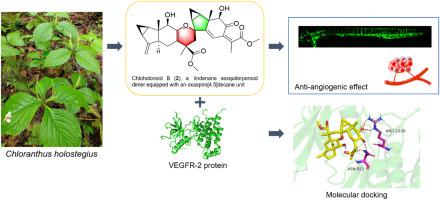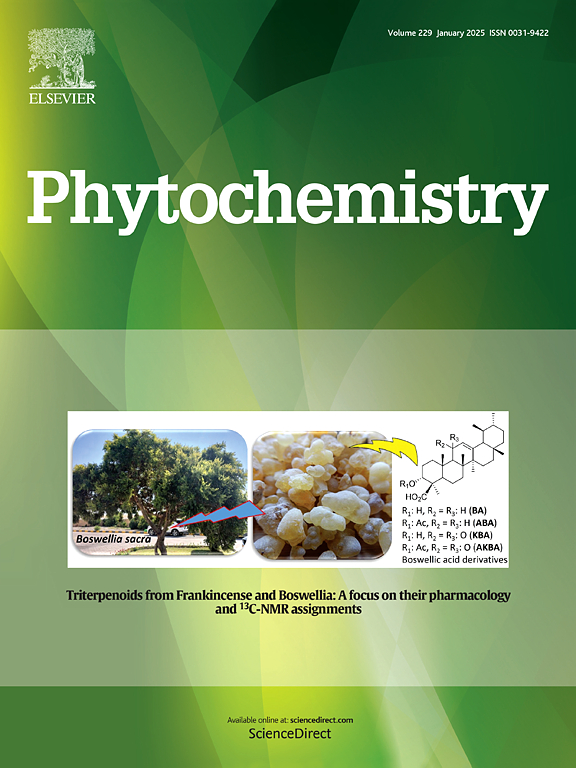以亲和筛选为导向,发现全叶绿耳中vegfr靶向成分。
IF 3.4
2区 生物学
Q2 BIOCHEMISTRY & MOLECULAR BIOLOGY
引用次数: 0
摘要
天然产物仍然是药物开发不可缺少的资源。本研究的重点是从全骨绿草中发现靶向血管内皮生长因子受体2 (VEGFR-2)的生物活性化合物。我们的植物化学分析导致6个先前未描述的倍半萜衍生物(1-6)和7个已知的类似物(7-13)的分离和结构阐明。通过集成的高分辨率电喷雾电离质谱和核磁共振光谱分析实现了全面的结构表征,并通过电子圆二色性计算建立了新化合物的绝对构型。在六个未描述的化合物中,1和2被鉴定为罕见的由1,2-二氧六环部分融合的单萜烯异二聚体和前所未有的具有oxspiro[4.5]十烷单元的林烯烷倍半萜二聚体。亲和超滤结合超高效液相色谱-质谱法鉴定出7种潜在的VEGFR-2配体(2,3,7 - 10和12)。分子对接研究阐明了这些化合物与VEGFR-2之间的相互作用。随后在转基因斑马鱼模型中进行的体内评估证实了多种候选药物的有效抗血管生成作用,其中化合物2在本研究中显示出最强的抗血管生成作用。本研究验证了C. holostegius作为抗癌药物开发的一个有希望的来源,同时鉴定了结构新颖的VEGFR-2抑制剂,并证明了其生物学功效。这些发现为推进基于天然产物的抗血管生成疗法提供了化学基础和药理学基础。本文章由计算机程序翻译,如有差异,请以英文原文为准。

Discovering VEGFR-targeting constituents from Chloranthus holostegius guided by affinity screening
Natural products remain an indispensable resource for pharmaceutical exploration. This investigation focuses on discovering bioactive compounds that target the vascular endothelial growth factor receptor 2 (VEGFR-2) from Chloranthus holostegius. Our phytochemical analysis led to the isolation and structural elucidation of six previously undescribed sesquiterpene derivatives (1–6) and seven known analogs (7–13). Comprehensive structural characterization was achieved through integrated high-resolution electrospray ionization mass spectrometry and nuclear magnetic resonance spectroscopic analysis, with the absolute configurations of the undescribed compounds established via electronic circular dichroism calculations. Among the six undescribed compounds, 1 and 2 were identified as a rare lindenane-monoterpene heterodimer fused by a 1,2-dioxane moiety and an lindenane sesquiterpenoid dimer featuring an oxaspiro[4.5]decane unit, respectively. Affinity ultrafiltration combined with ultra-performance liquid chromatography-mass spectrometry identified seven potential ligands for VEGFR-2 (2, 3, 7–10, and 12). Molecular docking studies elucidated the interactions between these compounds and VEGFR-2. Subsequent in vivo evaluations in transgenic zebrafish models confirmed potent anti-angiogenic effects for multiple candidates, with compound 2 demonstrating the strongest anti-angiogenic effects in this study. This study validates C. holostegius as a promising source for anticancer drug development while identifying structurally novel VEGFR-2 inhibitors with demonstrated biological efficacy. The findings provide both a chemical foundation and pharmacological rationale for advancing natural product-based anti-angiogenic therapeutics.
求助全文
通过发布文献求助,成功后即可免费获取论文全文。
去求助
来源期刊

Phytochemistry
生物-植物科学
CiteScore
6.40
自引率
7.90%
发文量
443
审稿时长
39 days
期刊介绍:
Phytochemistry is a leading international journal publishing studies of plant chemistry, biochemistry, molecular biology and genetics, structure and bioactivities of phytochemicals, including ''-omics'' and bioinformatics/computational biology approaches. Phytochemistry is a primary source for papers dealing with phytochemicals, especially reports concerning their biosynthesis, regulation, and biological properties both in planta and as bioactive principles. Articles are published online as soon as possible as Articles-in-Press and in 12 volumes per year. Occasional topic-focussed special issues are published composed of papers from invited authors.
 求助内容:
求助内容: 应助结果提醒方式:
应助结果提醒方式:


